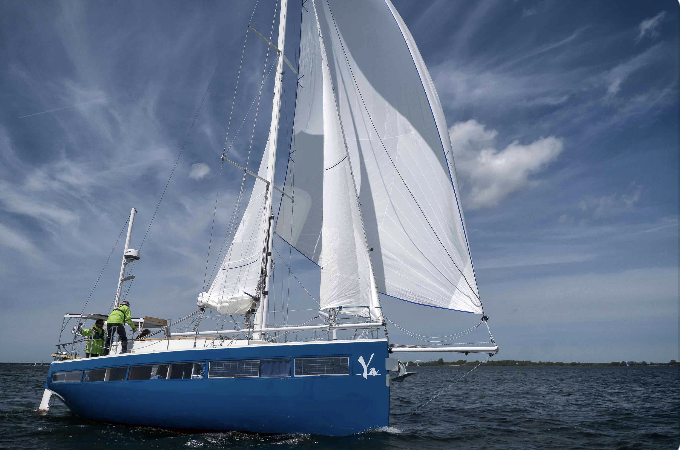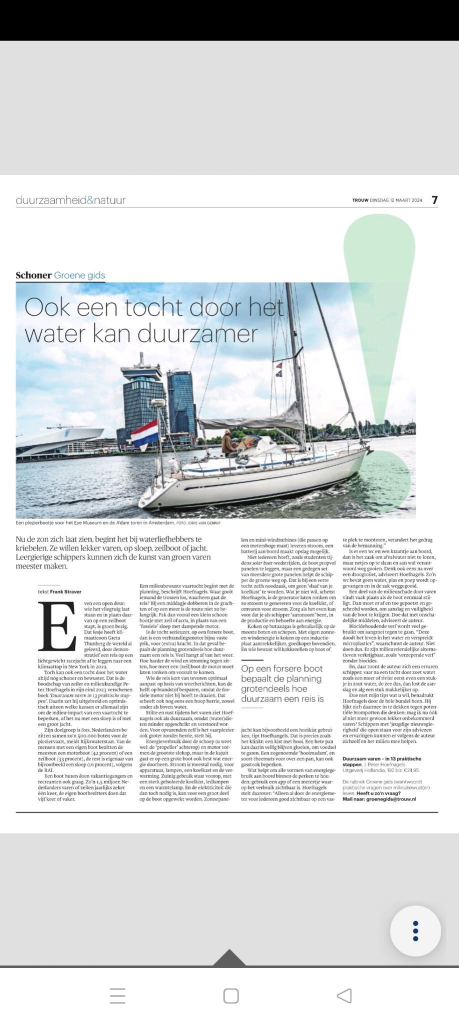The Sustainable Sailing book is also noticed by the national newspaper Trouw, and uses a full page to describe what the book is about.
Here the contents of article, in the English version. As well as the original Dutch article.

A trip through the water can also be more sustainable
(Translated from Trouw, Sustainability and Nature, p 8.)
Now that the sun is out, water lovers are starting to get the itch. They want to enjoy sailing, on a sloop, sailboat or yacht. Eager skippers can master the art of green sailing.
Let’s be clear: anyone who abandons the plane and gets on a sailboat instead is doing green. Climate icon Greta Thunberg has already taught the world this lesson by demonstratively taking a trip on a lightweight racing yacht to a climate summit in New York in 2019.
However, a trip through the water can always be even cleaner and more conscious. That is the message of sailor and environmental scientist Peter Hoefnagels in his book ‘Sustainable sailing in 13 practical steps’, published at the end of 2023. In it he explains extensively and optimistically the opportunities there are to limit the environmental impact of a boat trip, whether with a sloop or a large yacht.
His target group is large. The Dutch together own around 500,000 boats for pleasure boating, reports Rijkswaterstaat. Of the people with their own boat, most own a motorboat (42 percent) or a sailboat (33 percent), the rest own, for example, a sloop (16 percent), according to the RAI.
Holidaymakers and recreationists also like to rent a boat. About 1.5 million Dutch people sail or sail at least once a year, while private boat owners do so five times or more.
The planning of the boat trip is often the factor to sail sustainably.
An environmentally conscious boat trip starts with planning, Hoefnagels describes. Where does someone cast off, where does the journey go? When spending an afternoon floating in the canals or on a lake, the route is not that important. Then take a small clean boat with sail or battery, instead of a ‘fossil’ sloop with a steaming engine.
If the trip is more serious, on a larger boat, then a combustion engine is almost a must for (extra) power. In that case, planning largely determines how sustainable a trip is. A lot depends on the weather. The harder the wind and current are against you, the more a (sailing) boat has to rev the engine to move forward.
If you optimally adjust the trip shortly in advance based on weather reports, you can save half on fuel, because the fossil engine does not have to be turned on. That also saves a lot of noise, both under and above water.
Hoefnagels also sees silence and tranquility while sailing as sustainable, because (water) animals are less startled and disturbed. For the passengers themselves, sailing pleasure is also greater without noise, he says.
Energy consumption by the blade (you know: the ‘propeller’ on the back) and motor are the biggest drain, but quite a bit of energy also goes through the cabin on a large boat. Electricity is usually needed for equipment, lamps, a refrigerator and heating. Economical use is paramount, with a highly insulated cool box, LED lights and a heat lamp. And the electricity that is needed can largely be generated on the boat. Solar panels and mini wind turbines (which fit on a meter-high mast) provide power, and an onboard battery makes storage possible.
Not everyone has to pack the boat full of panels, like students during solar boat competitions, but a solid set of several large panels helps the skipper on the green road. This is even necessary when traveling long distances, so as not to become a ‘slave to your refrigerator’. What you don’t want, Hoefnagels outlines, is to run the generator to generate power for the cool box, or to detour for power. If possible, ensure that you as a skipper are ‘autonomous’ in terms of production and energy needs.
Cooking with butane gas is common on most boats and ships. With your own solar and wind energy, cooking on an induction hob is more attractive and also cheaper.
And if you want to consciously cook on a boat or yacht, you can use a hay box, for example, Hoefhangels recommends. That’s exactly what it sounds like: a box of hay. A hot pan can safely remain glowing to cook food. A so-called ‘hay dam’, a kind of tea cozy for over a pan, can also limit gas combustion.
What helps to keep all forms of energy consumption on board within limits: use an app or a meter on which consumption is visible. Hoefnagels states: “Just by mounting the energy meter in a permanent place that is clearly visible to everyone, the behavior of the crew changes.”
If there is a toilet and a tap on board, it is important not to discharge waste water, but to store it properly and dispose of it responsibly on shore. Also consider a dry toilet, Hoefnagels advises. Such a toilet contains no water, pee and poop are collected and thrown away in the bag.
Some of the environmental damage caused by boating often occurs once the boat is stationary. Then it needs to be cleaned and scrubbed occasionally to remove deposits and dirt from the boat. Do this with harmless means, the author advises.
Biocide-containing paint is widely used to prevent fouling. “This kills aquatic life and spreads microplastics,” the author warns. So don’t do that. Environmentally friendly alternatives are available, such as ‘saponifying paint’ without biocides.
And here the author shows himself to be an experienced skipper: after a trip through fresh water such as a lake or river, first sail for a while in salt water, i.e. the sea, then the deposits and algae will dissolve a lot easier.
Do what you want with my tips, Hoefnagels emphasizes throughout the entire volume. He seems to be protecting himself against potential grumblers who think: can’t I just sail without a care in the world anymore? According to the author, skippers with ‘youthful curiosity’ who are open to his advice and experiences can help themselves and the environment.
Sustainable sailing – in 13 practical steps, J. Peter Hoefnagels. Hollandia Publishers; 192 pages. €24.95.

